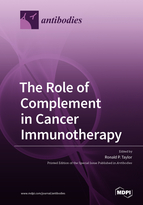The Role of Complement in Cancer Immunotherapy
A special issue of Antibodies (ISSN 2073-4468).
Deadline for manuscript submissions: closed (15 August 2020) | Viewed by 60702
Special Issue Editor
Special Issue Information
Dear Colleagues,
The dual role of complement in either the development or therapy of cancer has been investigated extensively and is characterized by a substantial literature which documents conditions in which complement can either enhance tumor growth or promote killing of malignant cells. Indeed, there are now numerous examples of monoclonal antibodies (mAbs), either approved by the FDA, or under active investigation, which make use of complement in eliminating cancer cells. Although direct in vitro killing of mAb-opsonized cancer cell lines by complement-dependent cytotoxicity (CDC) can be readily demonstrated, challenges to translate these findings to the clinic are considerable and numerous strategies are being employed to maximize mAb-mediated CDC in cancer treatment. These approaches include: redesign of mAb dosing schedules; engineering the Fc regions of the mAbs to enhance complement activation; treatment with cocktails of mAbs that bind to several different sites on the targeted cells and thus potentially synergize in promoting CDC; and also neutralizing complement control proteins on malignant cells to weaken their defenses against complement. Target sites on malignant cells that have been successfully exploited for mAb-induced CDC include CD20, CD37, CD38, CD52, and Epidermal Growth Factor Receptors. MAbs specific for complement components have served as powerful analytical reagents to investigate the detailed mechanisms of CDC, and they have been employed to document complement activation by cancer cells and to examine the role of complement proteins (in particular C1q and fragments of C3 and C5) in supporting tumor growth. The use of polyclonal and mAb reagents has revealed a role for the intracellular complement system in cancer biology, and strategies that focus on the interaction of complement with the tumor microenvironment and examine the impact of the complotype on the response to immunotherapy in cancer should lead to additional mAb-based therapies. Along these lines, there is now increasing evidence that strategies which make use of mAbs or other agents to modulate the action of C3a/C5a or their respective receptors may also find use in cancer immunotherapy.
Prof. Dr. Ronald P. Taylor
Guest Editor
Manuscript Submission Information
Manuscripts should be submitted online at www.mdpi.com by registering and logging in to this website. Once you are registered, click here to go to the submission form. Manuscripts can be submitted until the deadline. All submissions that pass pre-check are peer-reviewed. Accepted papers will be published continuously in the journal (as soon as accepted) and will be listed together on the special issue website. Research articles, review articles as well as short communications are invited. For planned papers, a title and short abstract (about 100 words) can be sent to the Editorial Office for announcement on this website.
Submitted manuscripts should not have been published previously, nor be under consideration for publication elsewhere (except conference proceedings papers). All manuscripts are thoroughly refereed through a single-blind peer-review process. A guide for authors and other relevant information for submission of manuscripts is available on the Instructions for Authors page. Antibodies is an international peer-reviewed open access quarterly journal published by MDPI.
Please visit the Instructions for Authors page before submitting a manuscript. The Article Processing Charge (APC) for publication in this open access journal is 1800 CHF (Swiss Francs). Submitted papers should be well formatted and use good English. Authors may use MDPI's English editing service prior to publication or during author revisions.
Keywords
- angiogenesis
- B cell malignancies
- calcium fluxes
- complement control proteins
- complotype
- gC1qR
- intracellular complement system
- mouse models
- targeting CD19







